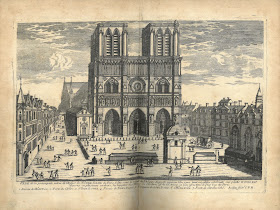 Here is a curious book. It contains multiple sets of engraved plates from the 18th century, mostly by Pierre-Alexander Aveline. The plates constitute different series of views of Paris and its surroundings. There is no title page, and there is no indication that it was ever issued in its current format.
Here is a curious book. It contains multiple sets of engraved plates from the 18th century, mostly by Pierre-Alexander Aveline. The plates constitute different series of views of Paris and its surroundings. There is no title page, and there is no indication that it was ever issued in its current format.So, why does it exist? We had a theory that it may have been some kind of sample book. Like a catalog in a shop where plates were housed. A tourist could look through the book and select an image to have printed to take home as a memento of his or her trip to Paris. But then we saw a description of a similar book of engraved plates that described it as a source book used in an artist's studio. Need a good Parisian backdrop? Take a look at the book of engravings and select one to work into your painting.
It is a pretty compelling explanation for the existence of a book like this. Ours has been rebound, so it lacks some important evidence of use, but it could well be a reference work of visual culture for others to sample. This is not yet cataloged, but you can see it by asking for it at our desk. The magic number we need to find it is 10110446. We welcome your theories!


